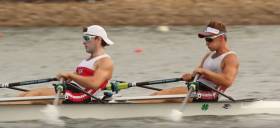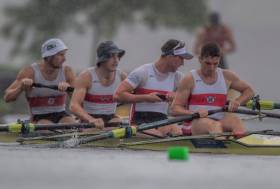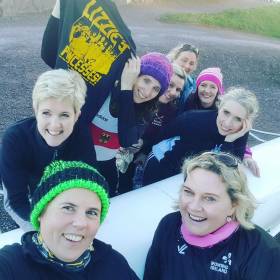Displaying items by tag: Skibbereen
O'Donovans Burn Off Rivals at Ireland Rowing Trials
#Rowing: Paul O’Donovan and Gary O’Donovan produced the best performance of the first Saturday session of the Ireland trials. The lightweight double beat their Skibbereen under-23 rivals Jake and Fintan McCarthy by 8.4 seconds and a heavyweight double of Ronan Byrne (UCC) and Philip Doyle (Queen’s) by 3.9 seconds.
The heavyweight pair of Shane O’Driscoll and Mark O’Donovan also put their challengers firmly behind them. They raced at a high rate in the good conditions and beat Patrick Boomer and Andy Harrington by 6.6 seconds.
Three senior women’s crews performed well. Single sculler Sanita Puspure and the heavyweight and lightweight doubles of Monika Dukarska and Aileen Crowley and Denise Walsh and Margaret Cremen all looked on form as the selectors decide on which crews to send to the World Cup Regatta in Belgrade.
In the junior trials, Annie O’Donoghue and Ciara Moynihan of Workmen’s won a fine doubles race. Aoibhinn Keating of Skibbereen and Ciara Browne of Workmen’s were their closest rivals, but Mollie Curry of Coleraine GS and Eimear Crowley of Kenmare contended at the finish and were just 1.4 seconds off the winners.
New September Event Presages Big Change in Irish Rowing
#Rowing: Rowing Ireland is set to add a new event to the calendar in September, the forerunner of a major calendar change. The new regatta, which will be incorporated into the Irish Open in September, will be for young rowers. It will become an anuual event, and grow each year until it incorporates competition for under-20 and under-22 rowers. Pat McInerney, who presented the proposal to the fixtures meeting ahead of the Rowing Ireland agm in Dublin today, agreed that it might, in time advance the case of holding the Irish Championships in September.
Antonio Maurogiovanni, the Ireland high performance director, flew in from the Ireland training camp for the fixtures meeting and agm. He was fully in favour of the new regatta and wished to see the Irish Championships move to September. Patrick Boomer, Andy Harrington, Ronan Byrne and Conor Egan have joined the Ireland camp in Varese.
A major change in the calendar for 2019 sees Skibbereen Regatta and Lough Rynn switch positions. Lough Rynn is now pencilled in for Sunday, April 14th, a day after a combined University and Schools Championships, while Skibbereen would run on May 4th and 5th. Trinity switched to May 11th and Portadown to May 4th.
Awards at Rowing Ireland AGM:
President’s: Gerry Cantan. Leinster: Kathryn Wall. Munster: Teresita O’Callaghan. Connacht: Micheal O Marcachain. Ulster: Ronald Walker (2018). Shane Kernan (2017).
Skibbereen Sunday in Doubt on Bumper Weekend for Irish Rowers
#Rowing: This weekend is one of the busiest of the year for Irish rowers. At the National Rowing Centre in Cork the University Championships of Ireland will be held on Friday, April 13th, and Skibbereen Grand League Regatta is scheduled for Saturday and Sunday, April 14th and 15th. This event has its biggest-ever entry, but a very bad weather forecast for the Sunday has put competition on that day in doubt. Three Ireland women’s crews will also compete in an international regatta in Italy, the Memorial Paolo d’Aloja in Piediluco.
World champions Mark O’Donovan and Shane O’Driscoll and Olympic medallists Paul O’Donovan and Gary O’Donovan arrived home earlier this week after three months training and competition in New Zealand and Australia. The four Skibbereen men intend to compete in their home club’s regatta.
On Friday, over 140 crews from 10 different universities and colleges around the country will compete in the University Championships. The event is set to start at 9:30 am with a straight final of the senior men’s fours and races will run throughout the day. The final contest, the men’s senior eights is scheduled for 4:20 pm.
In Italy, two-time Olympian Sanita Puspure will compete in the heavyweight women’s single sculls in Piediluco. Aileen Crowley and Monika Dukarska will race in a double scull, while Emily Hegarty and Aifric Keogh are set to compete in a pair.
Doyle Top Sculler as Sam McKeown Turns to Britain
#Rowing: The under-23 lightweight pair of David O’Malley and Shane Mulvaney were the most emphatic of winners on the first day of the Ireland trial at the National Rowing Centre in Cork, while Philip Doyle won the men’s single sculls – in the absence of Queen’s University clubmate Sam McKeown, who has gone to the British system.
Emily Hegarty and Aifric Keogh teamed up well in a women’s pair and Monika Dukarska was untroubled in a fine win in the women’s single sculls. Sanita Puspure is overcoming a back injury and Aileen Crowley, who has partnered Keogh in a pair, has tendonitis. Denise Walsh has tonsilitis.
Andrew Goff was the best of a talented, ambitious, group of lightweight single single scullers.
The junior ranks were vibrant and drew praise from Ireland high performance director Antonio Maurogiovanni. Fermoy’s Eliza O’Reilly and Gill McGirr confirmed their preeminence in the women’s pair, while Enniskillen’s Odhran Donaghy and Nathan Timoney were the best junior men’s pair. Aoibhinn Keating of Skibbereen was the top junior women’s sculler and Jack Dorney looked strong as he raced away to win the junior men’s single.
Ireland Assessment, National Rowing Centre (Selected Results; senior results not published)
Men – Junior
Pair – A Final: 1 O Donaghy, N Timoney (Enniskillen) 7:30.94, 2 S O’Neill, W Ronayne (Shandon) 7:36.03, 3 O’Donovan, Mulready (Castleconnell) 7:48.19. B Final: P Murphy, J Kennedy (Enniskillen) 7:48.76. Single – A Final: 1 J Dorney (Shandon) 7:45.34, 2 J Keating (Carlow) 7:53.06, 3 A Byrne (Shandon) 7:54.13. B Final: T Murphy (Lee) 8:00.55.
Women - Junior
Pair – A Final: 1 E O’Reill, G McGill. Single – A Final: 1 A Keating (Skibbereen) 8:46.75, 2 R Carson (Bann) 8:50.84, 3 C Moynihan (Workmen’s) 8:54.71. B Final: C O’Brien (Castleconnell) 8:46.50.
#Rowing: Jack Dorney was an impressive winner of the Junior 18 men’s single sculls final at the Ireland Assessment at the National Rowing Centre today. The Shandon man moved into a clear lead by the 1500 metre mark and won well from Jack Keating of Carlow, who finished well.
Odhran Donaghy and Nathan Timoney of Enniskillen won the Junior men’s pairs final from Sam O’Neill and William Ronayne of Shandon, who gave them a good battle to the line.
The Fermoy women’s junior pair of Gill McGirr and Eliza O’Reilly also won well in the women’s junior pair, while Aoibhinn Keating of Skibbereen won an exciting final of the Junior women’s single.
Fast Win in Sydney Heat for O'Donovan Brothers
#Rowing: Paul O’Donovan and Gary O’Donovan won their heat of the Open double sculls at the Sydney International Rowing Regatta in Australia. The Skibbereen duo had the fastest time of the two heats. They will compete in the A Final on Friday. The brothers are featured in the video below, scroll to 26 seconds in the timeline.
Mark O’ Donovan and Shane O’Driscoll took sixth place in their heat of the Open pair. They must compete in a repechage in an attempt to qualify for the A Final.
Sydney International Rowing Regatta, Day Two (Tuesday; Irish interest)
Men
Open Pair – Heat One (First two crews to A Final; rest to Repechages): 6 Skibbereen (M O’Donovan, S O’Driscoll) 7:03.94.
Open Double Sculls – Heat Two (First two crews to A Final; rest to Repechages): 1 Skibbereen (G O’Donovan, P O’Donovan) 6:24.19.
Skibbereen Four Take Premier Medal at New Zealand Championships
#Rowing: An Irish crew have taken a medal in the Premier grade at the New Zealand Rowing Championships. The Skibberen four of Gary O’Donovan, Paul O’Donovan, Mark O’Donovan and Shane O’Driscoll finished third in the Premier four, just a second ahead of fourth.
New Zealand Rowing Championships, Lake Karapiro, Day Five (Irish interest)
Men
Four – Premier
A Final: 3 Skibbereen (G O’Donovan, P O’Donovan, M O’Donovan, S O’Driscoll) 5:58.82.
Ireland Pair in Tight Finish in New Zealand
#Rowing: Mark O’Donovan and Shane O’Driscoll were eliminated from the Premier Pair at the New Zealand Rowing Championships on Wednesday (local time). The world lightweight pairs champions knew they would have some tough races as they learnt their trade in the heavyweight ranks, and this was one. In a tight repechage, rowed into a headwind, the Skibbereen men lost out by 1.64 seconds a three-way battle for the crucial third and fourth places which guaranteed a slot in the final.
Max Murphy secured a place in the final of the men’s senior pair, as his Waikato crew finished second in a repechage, while Eamon Power won his repechage of the club single sculls to secure a place in the semi-finals.
New Zealand Rowing Championships, Lake Karapiro, Day One (Irish interest; selected results)
Men
Pair – Premier - Repechage (Top Four to Final; rest eliminated): 5 Skibbereen (S O’Driscoll, M O’Donovan) 7:11.47.
Senior - Repechage (Top Three to Final): 2 Waikato (M Murphy, T Bedford) 7:33.13.
Sculling, Single – Club – Repechage One (First Two to Semi-Final): 1 Wairau (E Power) 8:19.07.
First Outing for O'Driscoll and O'Donovan as Heavyweights in New Zealand
#Rowing: Mark O’Donovan and Shane O’Driscoll competed as a heavyweight pair at the North Island Championships in New Zealand today. The world champions in the lightweight pair, who have switched to heavyweight in the hope of competing at the 2020 Olympic Games in Tokyo, finished fourth in their heat.
Paul O’Donovan and Gary O’Donovan both finished sixth in their heats of the single sculls. Both also competed as heavyweights.
All three boats move into repechages on Sunday.
Cork and Shandon In Form at Muckross Head
#Rowing: Cork Boat Club’s intermediate eight proved the fastest crew at the Muckross Head of the River at the National Rowing Centre. Shandon, who had a set of good results, saw their eight finish just five seconds off that pace – and their junior 18 quadruple took just nine minutes and 48 seconds to cover the course, placing them seventh overall. Justin Ryan of Skibbereen was the fastest single sculler.
The adult women’s ranks were thinner in numbers. Monika Dukarska was the fastest single sculler. A masters women’s crew from Lady Elizabeth and Dublin University Ladies Boat Club won: it featured well-known names, including former internationals Vanessa Lawrenson and Heather Boyle.
Muckross Head of the River – Selected Results
Overall: 1 Cork BC intermediate eight 9 mins 20 sec, 2 Shandon inter eight 9:25, 3 UCC senior quadruple 9:35.
Men, Eight – Intermediate: Cork 9:20. Club One: UCC 9:35. Club Two: UCC 9:44. Jun 16: Fermoy 10:35. Masters: Castleconnell 13:25.
Four – Sen: Shandon 9:56. Inter, coxed: Skibbereen 10:36. Club One: UCC 10:33. Jun 18, coxed: Presentation Col (D Murphy) 11:07
Pair – Sen: Skibbereen 10:54. Jun 18: Shandon 10:55.
Sculling, Quadruple – Sen: UCC 9:35. Club One, coxed: UCC 13:05. Club Two, coxed: Workmen’s 11:05. Masters, coxed: Clonmel 13:26. Jun 18: Shandon 9:48. Jun 16, coxed: Lee 10:56.
Double – Sen: UCC 11:33. Inter: UCC 10:37. Club One: Shandon 11:09. Jun 18: Skibbereen 11:11. Jun 16: Shandon 11:28.
Single – Sen: Skibbereen (J Ryan) 11:26. Inter: Castleconnell (P Silke) 12:00. Club One: Castleconnell 12:15. Club Two: Cork (R Povey) 12:16. Jun 18: Shandon (E Gaffney) 11:39. Jun 16: Tralee (B Winde) 12:57. Masters (H, adjusted): Lee Valley 13:40 (11:36).
Women,
Eight – Club One: Lee Valley 13:08. Club Two: Shandon 11:12. Jun 16: Muckross 12:28. Masters: Lady Elizabeth, Trinity 12:35.
Four – Sen: Skibbereen 11:36. Inter, coxed: Skibbereen 12:53. Club Two, coxed: Cork 12:22.
Pair – Sen: UCC/Skib 11:58.
Sculling, Quadruple - Sen: Workmen’s 10:50. Club One, coxed: Fermoy 12:14. Club Two, coxed: Lee 12:35. Jun 18: Workmen’s 11:12. Jun 16, coxed: Lee 12:29.
Double – Sen: Cork 11:41. Club One: Workmen’s 12:00. Jun 18: Workmen’s 11:49. Jun 16: Killorglin 12:19.
Single – Sen: Killorglin (M Dukarska) 11:54. Inter: Skibbereen (L Heaphy) 13:09. Club One: Lee Valley 13:08. Club Two: Killorglin (E O’Donovan) 13:35. Jun 18: Kenmare (E Crowley) 13:19. Jun 16: Killorglin (R O’Donoghue) 13:19. Masters: Clonmel (F, adjusted) 14:54 (13:26)




























































